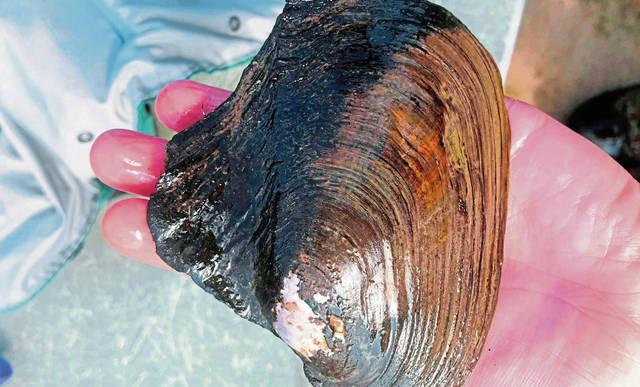Researchers went looking for a salamander not seen on the Kiski River for more than a century. Instead, they happened upon another river resident that has been missing from the Kiski equally as long or maybe longer – the pink heelsplitter mussel.
The Western Pennsylvania Conservancy recently reported its summer and fall surveying results: They found another harbinger of cleaner water in the Kiski River by surprise. A crew of scuba divers, snorkelers and water waders didn’t find the hellbender salamander they were looking for in early August, but they found the pink heelsplitter mussel at two of four sites where they dove.
“It’s an awesome find and it was an unexpected,” said Eric Chapman, director of aquatic science for the Western Pennsylvania Conservancy. “This second species of freshwater mussel will warrant future investigation in 2020.”
Fresh water mussels are not tolerant of pollutants, which indicates the Kiski is getting cleaner.
The heelsplitter is the second freshwater mussel species found after a century-long absence in the once highly polluted river, according to Charles Bier, senior director for conservation science at the Western Pennsylvania Conservancy.
Just several decades ago, nary a fish could survive in the Kiski, a major tributary of the Allegheny River, straddling Armstrong and Westmoreland counties, because of acid mine drainage.
“We’re building a story of recovery of the Kiskiminetas River,” Bier said.
In the last two years, area residents — one was fishing while another was participating in a river cleanup — found the hellbender and another variety of freshwater mussel known as a pocketbook.
Both had not been seen on the Kiski for at least a century, Bier said. And both are signs of vastly improved water quality.
“The improvements that people are trying to make with the mine discharges apparently are having an effect,” Bier said. “Fish populations are improving and some of the fresh water mussels are coming along as well,” he said.
Since 1999, the quality of the Kiski River has improved, according to the Conemaugh Valley Conservancy’s “State of the Kiski-Conemaugh River Watershed: Community Shift,” report published in 2017.
The number of fish species at two locations practically doubled from 1990 to 2015, according to the Pennsylvania Fish and Boat Commission.
The Kiski River was lifeless due to untreated mine drainage prior to 1980, when the coal industry was at its peak, according to the report.
Eventually, the waterway started to clean up after the coal and steel industry operations decreased, laws and regulations took effect, and local watershed groups started to get grants to work on land reclamation projects.
The Kiski Watershed Association and the Roaring Run Watershed Association received grants totaling more than $500,000 over the last several decades to install passive mine discharge treatment sites, which have stemmed the tide of mine pollution reaching the Kiski.
“A lot of other people came out and they wanted to see the same thing — a cleaner river,” said John Linkes, 68, of Leechburg, who sits on both the Kiski Watershed and Roaring Run boards of directors.
Linkes, who grew up in the North Vandergrift section of Parks Township, used to swim in the Kiski when he was a boy and the river ran orange from the mine drainage.
“I came home smelling like sulfur and the iron would turn my cut-off pants orange,” he said.
Although there is improvement in the Kiski, there is still much more work that needs to be done with acid mine drainage entering the Kiski and other waterways in the region, Linkes said.
The mussels in the Kiski come from the Allegheny River via catching a ride on a fish. Both mussel species found in the Kiski produce young as small as specks of dust that attach to fish, according to Bier.
The mussel apparently lives up to its name if someone would have the misfortune of stepping on one in the river without shoes, it would split you open, according to Bier and Chapman. The mussel has a fin-like attachment to its shell that stands erect and can be very sharp.
“The great news is, you have the Allegheny River there to repopulate,” Chapman said.
The pink heelsplitter was not found on the local rivers for a time and, then, in the late 1980s and early 1990s, they were found again, apparently moving upstream from the Ohio River, according to Bier.








